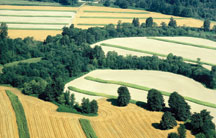
Challenging Perspectives
ASTM Standards Support New Thoughts on Environmental Risk Assessment
ASTM International standards figure prominently in a new book that its co-editor hopes will challenge practitioners of environmental risk assessment to improve the quality and relevance of their work.
According to longtime ASTM member Lawrence A. Kapustka, Environmental Risk Assessment and Management from a Landscape Perspective "is not a prescriptive ‘how-to' template but rather a provocative series of arguments intended to stimulate practitioners to engage their talents to produce more useful information for decision makers and affected stakeholders at large."
Kapustka, senior ecologist/ecotoxicologist, SLR Consulting, Calgary, Alberta, Canada, co-edited the book with Wayne G. Landis, director and professor of the Institute of Environmental Toxicology, Western Washington University, Bellingham, Wash.
Kapustka says that the roots of the new book go back to the early 1990s and his attempts to infuse contemporary ecology into the environmental risk assessment process.
"At the time, I was fortunate to have an industry-funded grant that allowed me to explore ways to incorporate wildlife habitat characteristics into the exposure assessment portion of ERA," notes Kapustka.
As Kapustka's research was nearing a conclusion, he led an effort to organize an ASTM symposium that resulted in STP 1458, Landscape Ecology and Wildlife Habitat Evaluation, which also led to Kapustka's work in leading the development of E2385, Guide for Estimating Wildlife Exposure Using Measures of Habitat Quality.
According to Kapustka, Environmental Risk Assessment and Management from a Landscape Perspective repeats a segment of information that he drew from his research on habitat evaluation and incorporated in E2385. Two other ASTM standards, E2348, Guide for Framework for a Consensus-Based Environmental Decision- Making Process, and E1689, Guide for Developing Conceptual Models for Contaminated Sites, are referenced in a description of environmental risk assessment that Kapustka provides in Chapter 2 of the book.
"These standards are relevant not only for the description of the basics of environmental risk assessment, but they are important in the move toward empowering affected stakeholders and communicating the relationships that exist among human societies and components of ecological systems," says Kapustka. "These are particularly important in the chapters on integrated holistic approaches and in the closing chapters that introduce economic ecology."
Kapustka has been an ASTM member since 1989. He has been chairman of Committee E47 on Biological Effects and Environmental Fate for the past three years and is also involved in Committees E50 on Environmental Assessment, Risk Management and Corrective Action, and E56 on Nanotechnology. In addition, Kapustka served as a member of the ASTM Committee on Technical Committee Operations from 2004 through 2006.
"As chair of E47, my main function is to maintain the standards that we currently have on the books," says Kapustka. "One initiative that I am pursuing is to evaluate current toxicity test methods for their utility in the emerging field of nanotechnology. As we identify needs for modification of existing standards or development of new test methods to characterize toxicological responses of organisms to various engineered nanoparticles, we will coordinate efforts with E56 on Nanotechnology."
Kapustka feels that his work on the book and his ASTM work are all part of his general philosophy of encouraging colleagues "to focus on getting the right science together to address contemporary environmental management issues."
 SN Home
SN Home Archive
Archive Advertisers
Advertisers Masthead
Masthead RateCard
RateCard Subscribe
Subscribe Email Editor
Email Editor